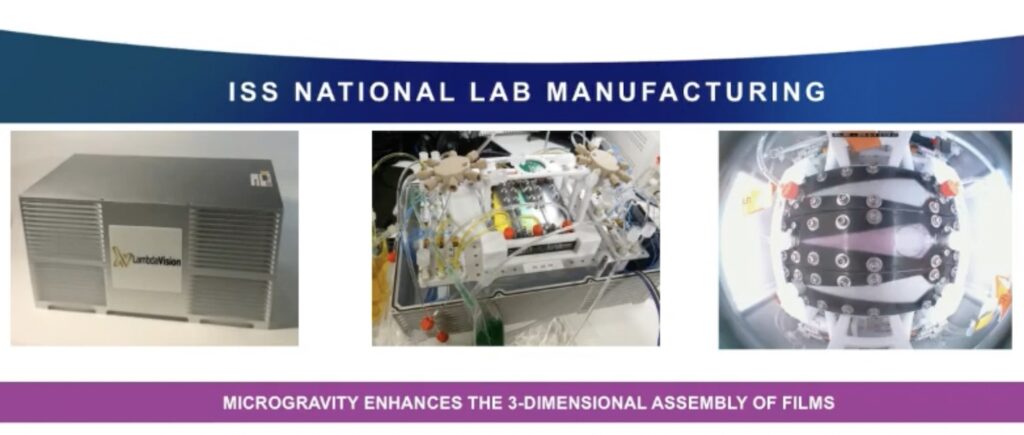by Christophe Bosquillon

Part 4: LambdaVision and the artificial retina
LambdaVision: a strong institutional backup from Connecticut to the ISS
As reviewed in Part 3, LambdaVision, based in Farmington, Connecticut, USA, was founded in 2009 by its President and CEO Dr. Nicole Wagner and co-founder chemist Jordan Greco. Dr. Robert Birge, distinguished chair in chemistry at the University of Connecticut, a renowned expert in the incorporation of light-activated proteins into biomolecular electronic and therapeutic applications, is a Member of the Board of Directors of the company.
As of 2022, LambdaVision had managed to raise over 10 million $ in a combination of life sciences, small business, and space-dedicated funding. The National Eye Institute (under the NIH), the National Science Foundation, the NASA SBIR & MassChallenge with Boeing, and the ISS under U.S. National Laboratory, have all contributed to make it happen. The company had keenly been aware for a while of the relevance and potential benefits of micro-G to their research and objectives to manufacture an artificial retina. But like many busy entrepreneurs, they had no idea about how to get the ball rolling for an ISS micro-G operation.
But as serendipity would have it, it all started around pizza at MassChallenge in 2016, a NASA ISSR&D conference. LambdaVision being a competition winner of the NASA MassChallenge CASSIS/BOEING Tech in Space Prize got involved through that program in micro-G research.
Space Tango, a perfect match as a micro-G implementation partner
In Part 2 we mentioned the importance of working with a micro-G implementation partner to figure out the payload and steps to get an experiment and manufacturing operation over to the ISS. We referred to Space Tango, which turns out to be the partner LambdaVision got paired with, and together they secured a $7 million contract to explore the benefits of micro-G on the production of the artificial retina.
NASA NRA Award and Phase II SBIR ended up supporting 6 flights to the ISS over 2 years (2020-2022) to evaluate and improve on-orbit processes for its “layer-by-layer electrostatic deposition” of proteins that produces a 200-layer thin film. NASA funding furthermore contributes to support any process improvement across a range of applications as well as the series of tests on the path toward commercialisation, a crucial step for LambdaVision.
While the NASA ISSR&D conference explaining ISS bio-printing and tissue engineering got LambdaVision to formally articulate the utility of micro-G and, the team got to develop a proposal jointly with Space Tango. The role of Space Tango is to develop the middleware and manage the logistics of getting the research and prototype working on the ISS. As seen in Part 2, you’re not going to move your laboratory and your staff to the ISS. LambdaVision was no exception: as their existing system was huge, it became necessary to miniaturise the process and fully automatise it. The endgame hardware practically ended up taking barely more space than a large shoebox.
They can become steady long-term customers for commercial space stations, for not only research but a neat case of micro-G manufacturing.
The team spent a lot of time dealing with bubble formation in micro-G, but they solved that too. They eventually got their proof of concept on the use of micro-G for that artificial retina. And the CubeLabTM hardware developed by Space Tango asserts itself as fulfilling 4 criteria for ISS manageability.
LambdaVision will be starting with the degenerative disease called Retinitis Pigmentosa, which affects « only » one and a half million people. This is what is called an “orphan disease”, and the relatively small number of cases makes it easier to manage clinical trials.
Flying 6 times to the ISS thanks to NASA SBIR and NRA funding
Between 2020 and 2022, LambdaVision completed six missions on the ISS National Lab, via NASA SBIR and NRA funding: SpaceX CRS-16, NG-14, NG-15, SpaceX CRS-24, Crew 4, and Crew 5. Overall, it was a resounding success. With a micro-G mission, you only get one shot at using your equipment, therefore you need to deliberately limit the number of variables you’re going to investigate, and which parameters of the process you intend to validate. LambdaVision achieved the following:
- The fluidics, operational controls, and in-process quality measurements were validated through the assembly of multiple artificial retina thin films in micro-G.
- Multiple 200-layer thin films have been manufactured in micro-G, and LambdaVision has a proven stack of the CubeLabTM jointly developed with Space Tango, with good control and automation.
The first 3 missions SpaceX CRS-16, NG-14, and NG-15 were conducted to ramp up the experiments.
The 4th mission, SpaceX CRS-24, was the crucial turning point:
- The first 200-layer film was completed in micro-gravity.
- Highly interactive operational capability allowed for protocol experimentation during flight.
- Some aggregate formation was observed that informed quality control processes.
- Images from each chamber and the data from monitoring fluidic behavior allowed LambdaVision to further develop quality systems for use on later flights.
- Lessons learned plus new ground-developed protocols allowed for rapid iteration.
- LambdaVision will get the extra data needed for clinical trial and commercialisation steps.
The 5th mission, SpaceX Crew 4, was built on successes from CRS-24 and terrestrial benchtop testing, which have demonstrated successful layering of LambdaVision’s artificial retina thin films.
The focus of SpaceX Crew 4 was to assemble multiple artificial retina thin films in micro-G and compare the quality of the films to terrestrial control films that are manufactured using a duplicate device on Earth.
The latest SpaceTango CubeLabsTM represents many important advancements in the hardware required for spaceflight. The validation used 2 CubeLabTM devices (named PAR04 and PAR05) with 2 chambers each and capable of producing 200-layer films. Then back at the Kennedy Space Center took place the step where they “de-integrate”: that means that they extract the thin film produced on the ISS from its device and compare terrestrial and space micro-G films with microscopy, for further improvements.
The 6th and last mission, SpaceX Crew 5, further carried on with assembly in micro-G of several artificial retina thin films for assessment against terrestrial controls, with the goal of improving film homogeneity. Across the 6 missions, the investigation has validated the improved fluidics. Furthermore, hardware upgrades improved operational controls, components redundancies, and in-process quality measurements that are necessary for successful production in Low Earth Orbit.
The way forward
The standard pharmaceutical industry protocol is to start by implementing pre-clinical trials on animals. LambdaVision successfully completed that first step, by using transgenic rats, and is now gearing up for Phase 1 clinical trials on humans in 2026. That is subject to timely filing in 2024-25 upon strengthening the manufacturing process and performing toxicity studies.
Clinical trials are traditionally performed over 3 phases, in most cases each phase may take a couple of years. Once all 3 phases have been completed, sometime in the 2030s, LambdaVision will get the necessary licenses and marketing authorizations from the FDA and relevant authorities. Since the 2000s, that process has been standardized between the US, Europe, and Japan, and authorizations in several markets can be obtained without having to repeat the entire process. These protocols are data-hungry and that’s why it was crucial for LambdaVision to maximize both terrestrial and ISS data.
With a micro-G mission, you only get one shot at using your equipment.
LambdaVision and its micro-G implementation partner Space Tango represent a robust business case, as it starts with the low demographics but high-value market of an orphan disease. With the appropriate financial and commercial funding, they can become steady long-term customers for commercial space stations, for not only research but a neat case of micro-G manufacturing.
Broader impacts and future applications
Bacteriorhodopsin-based applications, as shown by over 4 decades of research by Dr. Birch et al., expand beyond artificial retinas with use cases such as optical data storage, associative processing and neural networks, optical pattern recognition, and chemical/environmental toxin destruction. Furthermore, the Bacteriorhodopsin protein has the merit of moving protons around in an oriented and orderly fashion, it could also be used in biosensors, for wound healing, tissue engineering, anti-biofouling, and all kinds of products requiring good manufacturing practices.
Dr. Victor Buchli, an anthropologist and principal investigator leading an International research team about the “material and manufacturing culture on the ISS” had an opportunity to visit the LambdaVision labs in Farmington, Connecticut, and is looking at what it takes to grab something that is traditionally made terrestrially and bring it up to an orbital station.
Conclusion
Where is the industry heading? Here are 8 aspects we believe matter for micro-G business:
- Micro-G R&D and manufacturing require space stations in good financial standing. Other than China, by the 2030-40’s, there could be anywhere between one sole sustainable private replacement of the ISS, and near to half-a-dozen commercial stations IF there is a market.
- Governments will remain anchor customers of commercial space stations and of their clients.
- Stations are only one component of the transportation and orbital operation value chain. Quite as important is the availability of reusable vehicles flying to orbit that can safely return to Earth surface with micro-G payloads (and crews too). No reusable return vehicle, no terrestrial use.
- Europe will thrive: involved in US stations partnerships (Voyager Space and Airbus to build Starlab) Europe is furthermore active in the full transportation and orbital operation value chain for micro-G payloads and crews (The Exploration Company).
- Life sciences business spans decades from fundamental R&D to clinical trials phase to go-to-market phase: these long timelines are compatible with enduring space domain partnerships.
- As orbital micro-G R&D and manufacturing scale up for life sciences and industrial markets, automated and autonomous “dark factories” will emerge, based on a sound “low volume and weight, extremely high value payload” . This is the next orbital evolutionary step.
- Gentlemen, several of the above-mentioned ventures are led by women. In the larger scheme of things, societies that stifle strong women entrepreneurship and leadership will miss out.
- As more orbital logistics become commercially available, Emerging Space Countries and the Global South will be able to operate on their own terms. To enable access to and sharing of science, technology, education, and this universe of micro-G value and culture. So that all kids feel proud and confident they too can get in the space game and have a bright future.
Somehow, that 1970’s cat’s whisker has opened a door to a better world. Let’s make micro-G happen.
References
Activation of retinal ganglion cells using a biomimetic artificial retina, Greco et al., 2021
Opportunities for Biomanufacturing in Low Earth Orbit: Current Status and Future Directions, Giulianotti et al., 2021
Layer-by-Layer Deposition in Microgravity for Enhanced Thin-Film Production, Lawrence et al., 2022 (in In‐Space Manufacturing and Resources: Earth and Planetary Exploration Applications, Wiley-VCH)
Directed evolution of bacteriorhodopsin for applications in bioelectronics, NL Wagner, JAGreco, MJ Ranaghan, RR Birge (2013)

Christophe Bosquillon has a diverse professional background, having operated globally with a focus on the Indo-Pacific region. His experiences in Japan, the Koreas, Taiwan, China, ASEAN, India, Russia, and Australia have given him a deep understanding of the multipolar realpolitik of our world under the Pax Americana. With a background in engineering, trade, and foreign direct investment in industries relevant to Space Resource Utilization (SRU), such as mining, transportation, energy, manufacturing, agrifood, environment, and digitalization, Chris is committed to developing SRU value chains that benefit the Earth. As an executive, owner, writer, and founder of Autonomous Space Futures Ltd, Chris has extensive experience in collaborative policy crafting and works to develop space business and governance models relevant to society. He is a member of NGOs that provide input to the United Nations Committee on the Peaceful Uses of Outer Space (UNCOPUOS) legal subcommittee Working Group on Space Resources. Chris contributes to regulatory clarity on appropriation, priority, sustainability, and sharing in a way that balances national interests with civil society inclusion, provided a transparent due process is followed. When advocating for access to technology and space for the Global South, Chris believes that emerging space powers’ participation in space markets must be commensurate with their interest and involvement in international space politics. He believes that their ability to develop sovereign domestic capabilities with spillover potential is also essential. Chris is keen on ‘Peace Through Strength’ diplomacy and deterrence-based security as enablers of secure space access. He supports sovereign cislunar space situational awareness as mandatory for freedom of circulation in the space domain and deconflicted cooperation on the Moon.
 SpaceWatch.Global An independent perspective on space
SpaceWatch.Global An independent perspective on space




